Other common names
Cocklebur, rough cocklebur, clotbur, buttonbur, ditchbur
Scientific name
Xanthium strumarium
Family
Asteraceae
Description
Cocklebur grows 2 to 4 or more feet tall in a bushy, branched form. The plant is often described as coarse. Flowers are produced in the summer once the day length starts decreasing. The seeds and seedlings are toxic to livestock, and if eaten, can cause death.
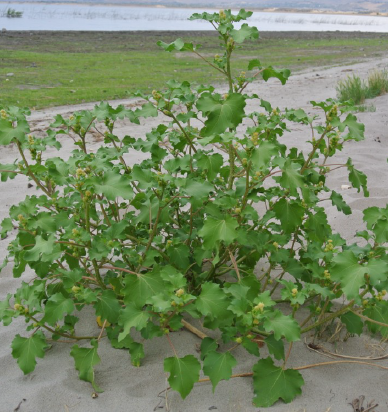
Typical plant growing in disturbed site. Photo by W, Hanson Mazet.
Leaves
Large, triangular or heart-shaped with stiff hairs and three to five irregular lobes and coarse teeth. Leaves are sandpapery on both sides and have long stalks.
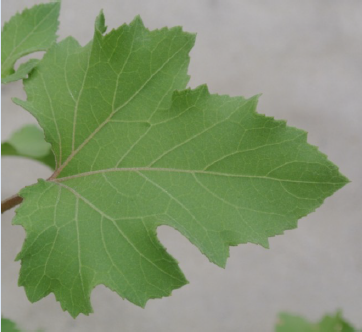
Leaves are large with 3 to 5 lobes and toothed edges. Photo by W. Hanson Mazet
Stems
Upright, thick, branched and rough, with hairs and bumps. Look for purple or black spots on the stems.
Flowers
Greenish or rusty-colored flowers form at ends of branches and where the leaves join the stems. Produces oval, brownish woody burs covered with prickles and hooks that stick to people and animals. The burs have two longer spines at the tips.
Roots
Grows a stout taproot.
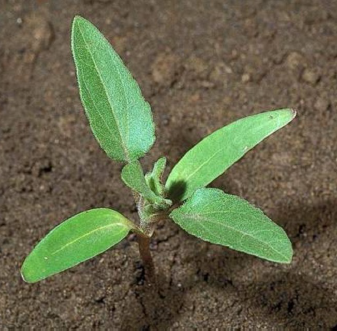
Seedlings leaves are pointy and shiny on the upper surface. Photo courtesy of J. DiTomaso, UCCE
Native to
North America
Where it grows
Croplands, pastures, roadsides, riparian areas, ditches and other moist, disturbed sites
Life cycle
Summer annual (sprouts in spring and summer, flowers and dies in a single year)
Reproduction
Reproduces by seed
Control methods
Control relies on preventing production of seed. The seed can remain dormant in the soil for years.
Mechanical
Dig, hoe or pull small patches before they set seed. Mowing is not an effective control measure, as plants will regrow.
Cultural
Encourage thick, competitive vegetation.
Biological
Livestock avoid this plant. Grazing is not an option due to toxicity. Insect biocontrols are being researched.
Chemical
Apply broadleaf-selective herbicides such as 2,4-D or 2,4-D+dicamba mixtures on young plants. Add a surfactant to improve uptake. Preemergence herbicides can be used to reduce the seed bank.
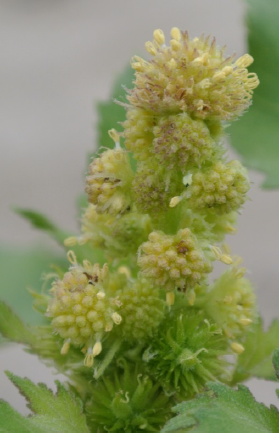
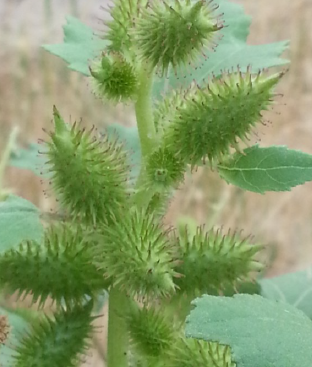
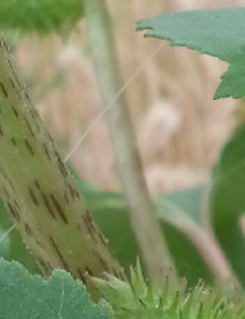
Stems have purple to black splotches. Burs dry out to a brownish color. Note the two long spines at the ends of the burs. Photos by W. Hanson Mazet
References
Pitcher, D. 2012. Xanthium strumarium. Global Invasive Species Team, The Nature Conservancy, WIKI.
DiTomaso, J.M. and E.A. Healy. 2007. Weeds of California and Other Western States. University of California Publication 3488.
UC IPM. 2011. Common cocklebur. IPM.
UC Berkeley Jepson Manual. 2012. Xanthium strumarium L., UC/JEPS.
USDA Plants Database. 2012. Rough cocklebur. USDA.
Whitson, Tom D. (editor). 2009. Weeds of the West. University of Wyoming, Jackson, Wyoming.
Donaldson, S. and Hanson Mazet, W.
2013,
A Northern Nevada Homeowner’s Guide to Identifying and Managing Common Cocklebur,
Extension | University of Nevada, Reno, FS-13-11


